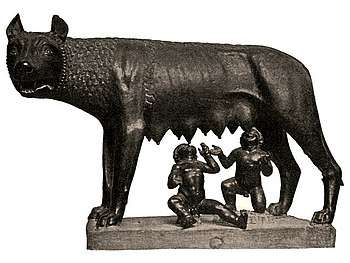Parasitoid
In evolutionary ecology, a parasitoid is an organism that lives in close association with its host at the host's expense, eventually resulting in the death of the host. Parasitoidism is one of six major evolutionary strategies within parasitism, distinguished by the fatal prognosis for the host, which makes the strategy close to predation.

Among parasitoids, strategies range from living inside the host (endoparasitism), allowing it to continue growing before emerging as an adult, to paralysing the host and living outside it (ectoparasitism). Hosts can include other parasitoids, resulting in hyperparasitism; in the case of oak galls, up to five levels of parasitism are possible. Some parasitoids influence their host's behaviour in ways that favour the propagation of the parasitoid.
Parasitoids are found in a variety of taxa across the insect order of endopterygote, whose complete metamorphosis may have pre-adapted them for a split lifestyle, with parasitoid larvae and freeliving adults. Most are in the Hymenoptera, where the ichneumons and many other parasitoid wasps are highly specialised for a parasitoidal way of life. Other parasitoids are in the Diptera, Coleoptera and other orders of endopterygote insects. Some of these, usually but not only wasps, are used in biological pest control.
The biology of parasitoidism has inspired science fiction authors and scriptwriters to create numerous parasitoidal aliens that kill their human hosts, such as the alien species in Ridley Scott's 1979 film Alien.
History
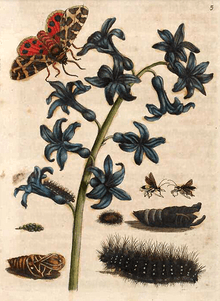
Maria Sibylla Merian (1647–1717) was one of the first naturalists to study and depict parasitoids.[2] The term "parasitoid" was coined in 1913 by the Swedo-Finnish writer Odo Reuter,[3] and adopted in English by his reviewer,[4] the entomologist William Morton Wheeler.[5] Reuter used it to describe the strategy where the parasite develops in or on the body of a single host individual, eventually killing that host, while the adult is free-living. Since that time, the concept has been generalised and widely applied.[6]
Strategies
Evolutionary options
A perspective on the evolutionary options can be gained by considering four questions: the effect on the fitness of a parasite's hosts; the number of hosts they have per life stage; whether the host is prevented from reproducing; and whether the effect depends on intensity (number of parasites per host). From this analysis, proposed by K. D. Lafferty and A. M. Kunis, the major evolutionary strategies of parasitism emerge, alongside predation.[7]
| Host fitness | Single host, stays alive | Single host, dies | Multiple hosts |
|---|---|---|---|
| Able to reproduce (fitness > 0) | Conventional parasite Pathogen | Trophically transmitted parasite[lower-alpha 2] Trophically transmitted pathogen | Micropredator Micropredator |
| Unable to reproduce (fitness = 0) | ----- Parasitic castrator | Trophically transmitted parasitic castrator Parasitoid | Social predator[lower-alpha 3] Solitary predator |
Parasitoidism, in the view of R. Poulin and H. S. Randhawa, is one of six main evolutionary strategies within parasitism, the others being parasitic castrator, directly transmitted parasite, trophically transmitted parasite, vector-transmitted parasite, and micropredator. These are adaptive peaks, with many possible intermediate strategies, but organisms in many different groups have consistently converged on these six.[8][9]
Parasitoids feed on a living host which they eventually kill, typically before it can produce offspring, whereas conventional parasites usually do not kill their hosts, and predators typically kill their prey immediately.[10][11]
Basic concepts
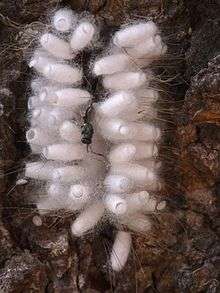
Parasitoids can be classified as either endo- or ectoparasitoids with idiobiont or koinobiont developmental strategies. Endoparasitoids live within their host's body, while ectoparasitoids feed on the host from outside. Idiobiont parasitoids prevent further development of the host after initially immobilizing it, whereas koinobiont parasitoids allow the host to continue its development while feeding upon it. Most ectoparasitoids are idiobiont, as the host could damage or dislodge the external parasitoid if allowed to move and moult. Most endoparasitoids are koinobionts, giving them the advantage of a host that continues to grow larger and avoid predators.[12]
Primary parasitoids have the simplest parasitic relationship, involving two organisms, the host and the parasitoid. Hyperparasitoids are parasitoids of parasitoids; secondary parasitoids have a primary parasitoid as their host, so there are three organisms involved. Hyperparasitoids are either facultative (can be a primary parasitoid or a hyperparasitoid depending on the situation) or obligate (always develop as a hyperparasitoid). Levels of parasitoids beyond secondary also occur, especially among facultative parasitoids. In oak gall systems, there can be up to five levels of parasitism.[13] Cases in which two or more species of parasitoids simultaneously attack the same host without parasitizing each other are called multi- or multiple parasitism. In many cases, multiple parasitism still leads to the death of one or more of the parasitoids involved. If multiple parasitoids of the same species coexist in a single host, it is called superparasitism. Gregarious species lay multiple eggs or polyembryonic eggs which lead to multiple larvae in a single host. The end result of gregarious superparasitism can be a single surviving parasitoid individual or multiple surviving individuals, depending on the species. If superparasitism occurs accidentally in normally solitary species the larvae often fight among themselves until only one is left.[14][15]
Influencing host behaviour

In another strategy, some parasitoids influence the host's behaviour in ways that favour the propagation of the parasitoid, often at the cost of the host's life. A spectacular example is the lancet liver fluke, which causes host ants to die clinging to grass stalks, where grazers or birds may be expected to eat them and complete the parasitoidal fluke's life cycle in its definitive host. Similarly, as strepsipteran parasitoids of ants mature, they cause the hosts to climb high on grass stalks, positions that are risky, but favour the emergence of the strepsipterans.[16] Among pathogens of mammals, the rabies virus affects the host's central nervous system, eventually killing it, but perhaps helping to disseminate the virus by modifying the host's behaviour.[17] Among the parasitic wasps, Glyptapanteles modifies the behaviour of its host caterpillar to defend the pupae of the wasps after they emerge from the caterpillar's body.[18] The phorid fly Apocephalus borealis oviposits into the abdomen of its hosts, including honey bees, causing them to abandon their nest, flying from it at night and soon dying, allowing the next generation of flies to emerge outside the hive.[19]
Taxonomic range
About 10% of described insects are parasitoids, in the orders Hymenoptera, Diptera, Coleoptera, Neuroptera, Lepidoptera, Strepsiptera, and Trichoptera. The majority are wasps within the Hymenoptera; most of the others are Dipteran flies.[6][20][21] Parasitoidism has evolved independently many times: once each in Hymenoptera, Strepsiptera, Neuroptera, and Trichoptera, twice in the Lepidoptera, 10 times or more in Coleoptera, and no less than 21 times among the Diptera. These are all holometabolous insects (Endopterygota, which form a single clade), and it is always the larvae that are parasitoidal.[22] The metamorphosis from active larva to an adult with a different body structure permits the dual lifestyle of parasitic larva, freeliving adult in this group.[23] These relationships are shown on the phylogenetic tree;[24][25] groups containing parasitoids are shown in boldface, e.g. Coleoptera, with the number of times parasitoidism evolved in the group in parentheses, e.g. (10 clades). The approximate number (estimates can vary widely) of parasitoid species[26] out of the total is shown in square brackets, e.g. [2,500 of 400,000].
| Endopterygota |
| ||||||||||||||||||||||||||||||||||||||||||||||||||||||||||||||||||||||||
Hymenoptera
Within the Hymenoptera, parasitoidism evolved just once, and the many described[lower-alpha 4] species of parasitoid wasps[27] represent the great majority of species in the order, barring those like the ants, bees, and Vespidae wasps that have secondarily lost the parasitoid habit. The parasitoid wasps include some 25,000 Ichneumonoidea, 22,000 Chalcidoidea, 5,500 Vespoidea, 4,000 Platygastroidea, 3,000 Chrysidoidea, 2,300 Cynipoidea, and many smaller families.[26] These often have remarkable life cycles.[28] They can be classified as either endoparasitic or ectoparasitic according to where they lay their eggs.[29] Endoparasitic wasps insert their eggs inside their host, usually as koinobionts, allowing the host to continue to grow (thus providing more food to the wasp larvae), moult, and evade predators. Ectoparasitic wasps deposit theirs outside the host's body, usually as idiobionts, immediately paralysing the host to prevent it from escaping or throwing off the parasite. They often carry the host to a nest where it will remain undisturbed for the wasp larva to feed on.[6] Most species of wasps attack the eggs or larvae of their host, but some attack adults. Oviposition depends on finding the host and on evading host defenses; the ovipositor is a tube-like organ used to inject eggs into hosts, sometimes much longer than the wasp's body.[30][31][32] Hosts such as ants often behave as if aware of the wasps' presence, making violent movements to prevent oviposition. Wasps may wait for the host to stop moving, and then attack suddenly.[33]
Parasitoid wasps face a range of obstacles to oviposition,[6] including behavioural, morphological, physiological and immunological defenses of their hosts.[29][34] To thwart this, some wasps inundate their host with their eggs so as to overload its immune system's ability to encapsulate foreign bodies;[35] others introduce a virus which interferes with the host's immune system.[36] Some parasitoid wasps locate hosts by detecting the chemicals that plants release to defend against insect herbivores.[37]
Other orders
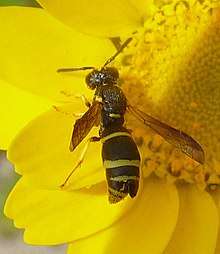
The true flies (Diptera) include several families of parasitoids, the largest of which is the Tachinidae (some 9,200 species[26]), followed by the Bombyliidae (some 4,500 species[26]), along with the Pipunculidae and the Conopidae, which includes parasitoidal genera such as Stylogaster. Other families of flies include some protelean species.[38] Some Phoridae are parasitoids of ants.[39][40] Some flesh flies are parasitoids: for instance Emblemasoma auditrix is parasitoidal on cicadas, locating its host by sound.[41]
The Strepsiptera (twisted-wing parasites) consist entirely of parasitoids; they usually sterilise their hosts.[42]
Two beetle families, Ripiphoridae (450 species[26])[43][44] and Rhipiceridae, are largely parasitoids, as are Aleochara Staphylinidae; in all, some 400 staphylinids are parasitoidal.[26][38][45] Some 1,600 species of the large and mainly freeliving family Carabidae are parasitoids.[26]
A few Neuroptera are parasitoidal; they have larvae that actively search for hosts.[46] The larvae of some Mantispidae, subfamily Symphrasinae, are parasitoids of other arthropods including bees and wasps.[26]
Although nearly all Lepidoptera (butterflies and moths) are herbivorous, a few species are parasitic. The larvae of Epipyropidae feed on Homoptera such as leafhoppers and cicadas, and sometimes on other Lepidoptera. The larvae of Cyclotornidae parasitise first Homoptera and later ant brood.[47] The pyralid moth Chalcoela has been used in biological control of the wasp Polistes in the Galapagos Islands.[22]
Parasitism is rare in the Trichoptera (caddisflies), but it is found among the Hydroptilidae (purse-case caddisflies), probably including all 10 species in the Orthotrichia aberrans group; they parasitise the pupae of other trichopterans.[48]
In biological pest control
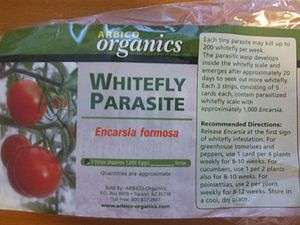
Parasitoids are among the most widely used biological control agents. Classic biological pest control using natural enemies of pests (parasitoids or predators) is extremely cost effective, the cost/benefit ratio for classic control being 1:250, but the technique is more variable in its effects than pesticides; it reduces rather than eliminates pests. The cost/benefit ratio for screening natural enemies is similarly far higher than for screening chemicals: 1:30 against 1:5 respectively, since the search for suitable natural enemies can be guided accurately with ecological knowledge. Natural enemies are more difficult to produce and to distribute than chemicals, as they have a shelf life of weeks at most; and they face a commercial obstacle, namely that they cannot be patented.[49][50]
From the point of view of the farmer or horticulturalist, the most important groups are the ichneumonid wasps, which prey mainly on caterpillars of butterflies and moths; braconid wasps, which attack caterpillars and a wide range of other insects including greenfly; chalcid wasps, which parasitise eggs and larvae of greenfly, whitefly, cabbage caterpillars, and scale insects; and tachinid flies, which parasitize a wide range of insects including caterpillars, adult and larval beetles, and true bugs.[51] Commercially, there are two types of rearing systems: short-term seasonal daily output with high production of parasitoids per day, and long-term year-round low daily output with a range in production of 4–1000 million female parasitoids per week, to meet demand for suitable biological control agents for different crops.[52][53]
In culture
Charles Darwin
Parasitoids influenced the thinking of Charles Darwin,[lower-alpha 5] who wrote in an 1860 letter to the American naturalist Asa Gray: "I cannot persuade myself that a beneficent and omnipotent God would have designedly created parasitic wasps with the express intention of their feeding within the living bodies of Caterpillars."[55] The palaeontologist Donald Prothero notes that religiously minded people of the Victorian era, including Darwin, were horrified by this instance of evident cruelty in nature, particularly noticeable in the Ichneumonidae wasps.[56]
In science fiction
Parasitoids have inspired science fiction authors and screenwriters to create terrifying parasitic alien species that kill their human hosts.[59] One of the best-known is the Xenomorph in Ridley Scott's 1979 film Alien, which runs rapidly through its lifecycle from violently entering a human host's mouth to bursting fatally from the host's chest.[60][61][62] The molecular biologist Alex Sercel, writing in Signal to Noise Magazine, compares "the biology of the [Alien] Xenomorphs to parasitoid wasps and nematomorph worms from Earth to illustrate how close to reality the biology of these aliens is and to discuss this exceptional instance of science inspiring artists".[63] Sercel notes that the way the Xenomorph grasps a human's face to implant its embryo is comparable to the way a parasitoid wasp lays its eggs in a living host. He further compares the Xenomorph life cycle to that of the nematomorph Paragordius tricuspidatus which grows to fill its host's body cavity before bursting out and killing it.[63] Alistair Dove, on the science website Deep Sea News, writes that there are multiple parallels with parasitoids, though there are in his view more disturbing life cycles in real biology. In his view, the parallels include the placing of an embryo in the host; its growth in the host; the resulting death of the host; and alternating generations, as in the Digenea (trematodes).[64] The social anthropologist Marika Moisseeff argues that "The parasitical and swarming aspects of insect reproduction make these animals favored bad-guy characters in Hollywood science fiction. The battle of culture against nature is depicted as an unending combat between humanity and insect-like extraterrestrial species that tend to parasitize human beings in order to reproduce."[59] The Encyclopedia of Science Fiction lists many instances of "parasitism", often causing the host's death.[65]
Notes
- The species has been introduced to Australia to control the spotted alfalfa aphid.[1]
- Trophically transmitted parasites are transmitted to their definitive host, a predator, when their intermediate host is eaten. These parasites often modify the behaviour of their intermediate hosts, causing them to behave in a way that makes them likely to be eaten, such as by climbing to a conspicuous point: this gets the parasites transmitted at the cost of the intermediate host's life.
- The wolf is a social predator, hunting in packs; the cheetah is a solitary predator, hunting alone. Neither strategy is conventionally considered parasitic.
- There may be far more species of parasitoid wasp not yet described.
- Darwin mentions "parasitic" wasps in On the Origin of Species, Chapter 7, page 218.[54]
References
- Wilson, C. G.; Swincer, D. E.; Walden, K. J. (1982). "The Introduction of Trioxys Complanatus Quilis (Hymenoptera: Aphidiidae), an Internal Parasite of the Spotted Alfalfa Aphid, into South Australia". Australian Journal of Entomology. 21 (1): 13–27. doi:10.1111/j.1440-6055.1982.tb01758.x.
- Todd, Kim (2011). "Maria Sibylla Merian (1647-1717): an early investigator of parasitoids and phenotypic plasticity". Terrestrial Arthropod Reviews. 4 (2): 131–144. doi:10.1163/187498311X567794.
- Reuter, Odo M. (1913). Lebensgewohnheiten und Instinkte der Insekten [Habits and instincts of the insects up to the awakening of social instincts] (in German). R. Friedländer und Sohn.
- Wheeler, W. M. (9 January 1914). "Scientific Books | Lebensgewohnheiten und Instinkte der Insekten bis zum Erwachen der sozialen Instinkte". Science. American Association for the Advancement of Science (AAAS). 39 (993): 69–71. doi:10.1126/science.39.993.69.
- Wheeler, William Morton (1923). Social life among the insects: being a series of lectures delivered at the Lowell Institute in Boston in March 1922. Harcourt, Brace. Previously published in Scientific Monthly, June 1922 to February 1923.
- Godfray, H. C. J. (1994). Parasitoids: Behavioral and Evolutionary Ecology. Princeton University Press. ISBN 978-0-691-00047-3.
- Lafferty, K. D.; Kuris, A. M. (2002). "Trophic strategies, animal diversity and body size". Trends Ecol. Evol. 17 (11): 507–513. doi:10.1016/s0169-5347(02)02615-0.
- Poulin, Robert; Randhawa, Haseeb S. (February 2015). "Evolution of parasitism along convergent lines: from ecology to genomics". Parasitology. 142 (Supplement 1): S6–S15. doi:10.1017/S0031182013001674. PMC 4413784. PMID 24229807.
- Poulin, Robert (2011). Rollinson, D.; Hay, S. I. (eds.). The Many Roads to Parasitism: A Tale of Convergence. Advances in Parasitology. 74. Academic Press. pp. 27–28. doi:10.1016/B978-0-12-385897-9.00001-X. ISBN 978-0-12-385897-9. PMID 21295676.
- Stevens, Alison N. P. (2010). "Predation, Herbivory, and Parasitism". Nature Education Knowledge. 3 (10): 36. Retrieved 12 February 2018.
Predation, herbivory, and parasitism exist along a continuum of severity in terms of the extent to which they negatively affect an organism's fitness. ... In most situations, parasites do not kill their hosts. An exception, however, occurs with parasitoids, which blur the line between parasitism and predation.
- Møller, A. P. (1990). "Effects of parasitism by a haematophagous mite on reproduction in the barn swallow". Ecology. 71 (6): 2345–2357. doi:10.2307/1938645. JSTOR 1938645.
- Gullan, P. J.; Cranston, P. S. (2014). The Insects: An Outline of Entomology (5th ed.). Wiley. pp. 362–370. ISBN 978-1-118-84615-5.
- Askew, R. R. (1961). "On the biology of the inhabitants of oak galls of Cynipidae (Hymenoptera) in Britain". Transactions of the Society for British Entomology. 14: 237–268.
- Gullan, P. J.; Cranston, P. S. (2014). The Insects: An Outline of Entomology (5th ed.). Wiley. pp. 365–369. ISBN 978-1-118-84615-5.
- Fisher, R. C. (1 June 1961). "A Study in Insect Multiparasitism: I. Host Selection and Oviposition" (PDF). Journal of Experimental Biology. 38 (2): 267–275.
- Wojcik, Daniel P. (March 1989). "Behavioral Interactions between Ants and Their Parasites". The Florida Entomologist. 72 (1): 43–51. doi:10.2307/3494966. JSTOR 3494966.
- Taylor, P. J. (December 1993). "A systematic and population genetic approach to the rabies problem in the yellow mongoose (Cynictis penicillata)". Onderstepoort J. Vet. Res. 60 (4): 379–87. PMID 7777324.
- Grosman, Amir H.; Janssen, Arne; Brito, Elaine F. de; Cordeiro, Eduardo G.; Colares, Felipe; Fonseca, Juliana Oliveira; Lima, Eraldo R.; Pallini, Angelo; Sabelis, Maurice W. (4 June 2008). "Parasitoid Increases Survival of Its Pupae by Inducing Hosts to Fight Predators". PLOS One. 3 (6): e2276. doi:10.1371/journal.pone.0002276. PMC 2386968. PMID 18523578.
- Core, Andrew; Runcke, Charles; Ivers, Jonathan; Quock, Christopher; Siapno, Travis; DeNault, Seraphina; Brown, Brian; DeRisi, Joseph; Smith, Christopher D.; Hafernik, John (2012). "A new threat to honey bees, the parasitic phorid fly Apocephalus borealis". PLoS ONE. 7 (1): e29639. doi:10.1371/journal.pone.0029639. PMC 3250467. PMID 22235317.
- Eggleton, P.; Belshaw, R. (1992). "Insect parasitoids: an evolutionary overview". Philosophical Transactions of the Royal Society B. 337 (1279): 1–20. doi:10.1098/rstb.1992.0079.
- Foottit, R. G.; Adler, P. H. (2009). Insect Biodiversity: Science and Society, Volume 1. Wiley-Blackwell. p. 656. ISBN 978-1118945537.
- Foottit, Robert G. (2017). Insect Biodiversity: Science and Society. John Wiley & Sons. p. 606. ISBN 978-1-118-94553-7.
- "Parasites (Parasitoids)". University of Alberta. Retrieved 10 March 2018.
- Niehuis, O.; Hartig, G.; Grath, S.; Pohl, H.; Lehmann, J.; Tafer, H.; Donath, A.; Krauss, V.; Eisenhardt, C.; Hertel, J.; Petersen, M.; Mayer, C.; Meusemann, K.; Peters, R.S.; Stadler, P.F.; Beutel, R.G.; Bornberg-Bauer, E.; McKenna, D.D.; Misof, B. (2012). "Genomic and Morphological Evidence Converge to Resolve the Enigma of Strepsiptera". Current Biology. 22 (14): 1309–1313. doi:10.1016/j.cub.2012.05.018. PMID 22704986.
- Colgan, Donald J.; Zhao, Chenjing; Liu, Xingyue; Yang, Ding (2014). "Wing Base Structural Data Support the Sister Relationship of Megaloptera and Neuroptera (Insecta: Neuropterida)". PLOS ONE. 9 (12): e114695. doi:10.1371/journal.pone.0114695. PMC 4263614. PMID 25502404.
- Mills, N. (2009). "Parasitoids". In V. H. Resh; R. T. Cardé (eds.). Encyclopedia of Insects (2nd ed.). Elsevier. pp. 748–750. ISBN 978-0123741448.
- Goulet, Henri; Huber, John Theodore (1993). Hymenoptera of the world : an identification guide to families. Centre for Land and Biological Resources Research. ISBN 978-0-660-14933-2. OCLC 28024976.
- Hochberg, M.; Elmes, G. W.; Thomas, J. A.; Clarke, R. T. (1996). "Mechanisms of local persistence in coupled host-parasitoid associations: the case model of Maculinea rebeli and Ichneumon eumerus". Philosophical Transactions of the Royal Society B: Biological Sciences. 351 (1348): 1713–1724. doi:10.1098/rstb.1996.0153.
- Apostolos, Kapranas; Tena, Alejandro; Luck, Robert F. (2012). "Dynamic virulence in a parasitoid wasp: the influence of clutch size and sequential oviposition on egg encapsulation". Animal Behaviour. 83 (3): 833–838. doi:10.1016/j.anbehav.2012.01.004.
- Gullan, P. J.; Cranston, P. S. (2010). The Insects: An Outline of Entomology (4th ed.). Wiley. pp. 364, 367. ISBN 978-1-118-84615-5.
- Gomez, Jose-Maria; van Achterberg, Cornelius (2011). "Oviposition behaviour of four ant parasitoids (Hymenoptera, Braconidae, Euphorinae, Neoneurini and Ichneumonidae, Hybrizontinae), with the description of three new European species". ZooKeys (125): 59–106. doi:10.3897/zookeys.125.1754. PMC 3185369. PMID 21998538.
- Quicke, D. L. J.; Fitton, M. G. (22 July 1995). "Ovipositor Steering Mechanisms in Parasitic Wasps of the Families Gasteruptiidae and Aulacidae (Hymenoptera)". Proceedings of the Royal Society B: Biological Sciences. The Royal Society. 261 (1360): 99–103. doi:10.1098/rspb.1995.0122.
The length of the ovipositor compared with the body of the parasitic wasp varies enormously between taxa, from being a fraction of the length of the metasoma to more than 14 times longer than the head and body. (Townes 1975; Achterberg 1986; Compton & Nefdt 1988).
- Van Achterberg Cornelius; Argaman Q. "Kollasmosoma gen. nov. and a key to the genera of the subfamily Neoneurinae (Hymenoptera: Braconidae)". Zoologische Mededelingen Leiden. 67. (1993):63-74.
- Schmidt, O.; Theopold, U.; Strand, M.R. (2001). "Innate immunity and evasion by insect parasitoids". BioEssays. 23 (4): 344–351. doi:10.1002/bies.1049. PMID 11268040.
- Salt, George (1968). "The resistance of insect parasitoids to the defense reactions of their hosts". Biological Reviews of the Cambridge Philosophical Society. 43 (2): 200–232. doi:10.1111/j.1469-185x.1968.tb00959.x. PMID 4869949.
- Summers, M. D.; Dib-Hajj (1995). "Polydnavirus-facilitated endoparasite protection against host immune defenses". PNAS. 92 (1): 29–36. doi:10.1073/pnas.92.1.29. PMC 42812. PMID 7816835.
- Kessler, Andre; Baldwin, Ian T. (2002). "Plant Responses to Insect Herbivory: The Emerging Molecular Analysis". Annual Review of Plant Biology. 53: 299–328. doi:10.1146/annurev.arplant.53.100301.135207. PMID 12221978.
- "Midwest Biological Control News". Department of Entomology at the University of Wisconsin–Madison.
- Wuellner, C. T.; et al. (2002). "Phorid Fly (Diptera: Phoridae) Oviposition Behavior and Fire Ant (Hymenoptera: Formicidae) Reaction to Attack Differ According to Phorid Species". Annals of the Entomological Society of America. 95 (2): 257–266. doi:10.1603/0013-8746(2002)095[0257:pfdpob]2.0.co;2.
- Feener, Jr., Donald H.; Jacobs, Lucia F.; Schmidt, Justin O. (January 1996). "Specialized parasitoid attracted to a pheromone of ants". Animal Behaviour. 51 (1): 61–66. doi:10.1006/anbe.1996.0005. ISSN 0003-3472.
- Köhler, U.; Lakes-Harlan, R. (October 2001). "Auditory behaviour of a parasitoid fly (Emblemasoma auditrix, Sarcophagidae, Diptera)". J Comp Physiol A. 187 (8): 581–587. doi:10.1007/s003590100230. PMID 11763956.
- Whiting, M. F. (2003). "Strepsiptera". In Resh, V. H.; Cardé, R. T. (eds.). Encyclopedia of Insects. Academic Press. pp. 1094–1096.
- Falin, Z. H. (2002). "102. Ripiphoridae. Gemminger and Harold 1870 (1853)". In Arnett, R.H. Jr; Thomas, M. C.; Skelley, P. E.; Frank, J. H. (eds.). American beetles. Volume 2. Polyphaga: Scarabaeoidea through Curculionoidea. CRC Press. pp. 431–444. doi:10.1201/9781420041231.ch6. ISBN 978-0-8493-0954-0.
- Lawrence, J. F.; Falin, Z. H.; Ślipiński, A. (2010). "Ripiphoridae Gemminger and Harold, 1870 (Gerstaecker, 1855)". In Leschen, R. A. B.; Beutel, R. G.; Lawrence, J. F. (eds.). Coleoptera, beetles. Volume 2: Morphology and systematics (Elateroidea, Bostrichiformia, Cucujiformia partim). New York: Walter de Gruyter. pp. 538–548. doi:10.1515/9783110911213.538. ISBN 978-3-11-019075-5.
- Yamamoto, Shûhei; Maruyama, Munetoshi (2016). "Revision of the subgenus Aleochara Gravenhorst of the parasitoid rove beetle genus Aleochara Gravenhorst of Japan (Coleoptera: Staphylinidae: Aleocharinae)". Zootaxa. 4101 (1): 1–68. doi:10.11646/zootaxa.4101.1.1. PMID 27394607.
- Godfray, H. C. J. (1994). Parasitoids: Behavioral and Evolutionary Ecology. Princeton University Press. p. 40. ISBN 978-0-691-00047-3.
- Pierce, Naomi E. (1995). "Predatory and Parasitic Lepidoptera: Carnivores Living on Plants" (PDF). Journal of the Lepidopterists' Society. 49 (4): 412–453.
- Wells, Alice (2005). "Parasitism by hydroptilid caddisflies (Trichoptera) and seven new species of Hydroptilidae from northern Queensland". Australian Journal of Entomology. 44 (4): 385–391. doi:10.1111/j.1440-6055.2005.00492.x.
- Bale, J.S; van Lenteren, J.C; Bigler, F (February 2008). "Biological control and sustainable food production". Philosophical Transactions of the Royal Society B: Biological Sciences. The Royal Society. 363 (1492): 761–776. doi:10.1098/rstb.2007.2182. PMC 2610108. PMID 17827110.
- Legner, Erich F. "Economic Gains & Analysis Of Successes In Biological Pest Control". University of California, Riverside. Archived from the original on 23 June 2008. Retrieved 13 February 2018.
- "Parasitoid Wasps (Hymenoptera)". University of Maryland. Retrieved 6 June 2016.
- Smith, S. M. (1996). "Biological control with Trichogramma: advances, successes, and potential of their use". Annual Review of Entomology. 41: 375–406. doi:10.1146/annurev.en.41.010196.002111. PMID 15012334.
- Wajnberg, E.; Hassan, S.A. (1994). Biological Control with Egg Parasitoids. CABI Publishing.
- On the Origin of Species, Chapter 7, page 218.
- "Letter 2814 — Darwin, C. R. to Gray, Asa, 22 May [1860]". Retrieved 5 April 2011.
- Prothero, Donald R. (2017). Evolution: What the Fossils Say and Why It Matters. Columbia University Press. pp. 84–86. ISBN 978-0-231-54316-3.
- Budanovic, Nikola (10 March 2018). "An explanation emerges for how the 12th century Paisley Abbey in Scotland could feature a gargoyle out of the film "Alien"". The Vintage News. Retrieved 17 June 2018.
- "'Alien' gargoyle on ancient Paisley Abbey". British Broadcasting Corporation. 23 August 2013. Retrieved 17 June 2018.
- Moisseeff, Marika (23 January 2014). "Aliens as an Invasive Reproductive Power in Science Fiction". HAL Archives-Ouvertes.
- Pappas, Stephanie (29 May 2012). "5 Alien Parasites and Their Real-World Counterparts". Live Science.
- Williams, Robyn; Field, Scott (27 September 1997). "Behaviour, Evolutionary Games and .... Aliens". Australian Broadcasting Corporation. Retrieved 30 November 2017.
- "The Making of Alien's Chestburster Scene". The Guardian. 13 October 2009. Archived from the original on 30 April 2010. Retrieved 29 May 2010.
- Sercel, Alex (19 May 2017). "Parasitism in the Alien Movies". Signal to Noise Magazine.
- Dove, Alistair (9 May 2011). "This is clearly an important species we're dealing with". Deep Sea News.
- "Parasitism and Symbiosis". The Encyclopedia of Science Fiction. 10 January 2016.
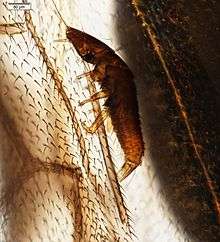
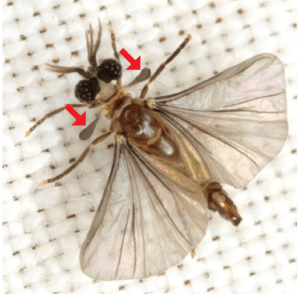
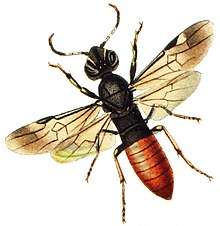
_(7686081848).jpg)
_(cropped).jpg)
_(cropped).jpg)
